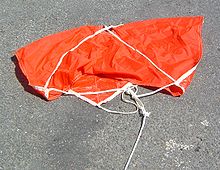
Back مرساة عائمة Arabic Плаваща котва Bulgarian Àncora de capa Catalan Drivanker Danish Treibanker German Ancla de capa Spanish Laahusankkuri Finnish Ancre flottante French Tracóg Irish Rekankeri Icelandic






A sea anchor (also known as a parachute anchor, drift anchor, drift sock, para-anchor or boat brake) is a device that is streamed from a boat in heavy weather. Its purpose is to stabilize the vessel and to limit progress through the water. Rather than tethering the boat to the seabed with a conventional anchor, a sea anchor provides hydrodynamic drag, thereby acting as a brake. Normally attached to a vessel's bows, a sea anchor can prevent the vessel from turning broadside to the waves and being overwhelmed by them.
Early sea anchors were crude devices, but today most take the form of a drogue parachute.[clarification needed] Larger sea anchors are so efficient that they need a tripping line to collapse the parachute for retrieval. Being made of fabric, a sea parachute may be bagged and easily stowed when not in use.
A similar device to the sea anchor is the much smaller drogue, which is streamed from a vessel's stern in strong winds so as to slow the boat to prevent pitchpoling or broaching in an overtaking sea. The fundamental difference between the sea anchor and the drogue is that the drogue will slow the boat while keeping the heading steady, and is intended to be launched from the stern. The parachute anchor is designed to be launched from the bow and effectively stop the boat's progress relative to the current in an open sea.
© MMXXIII Rich X Search. We shall prevail. All rights reserved. Rich X Search